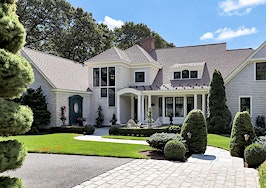2020 was a mixed bag for the real estate industry, with the coronavirus halting the spring homebuying season and sparking a wave of innovation that enabled plenty of agents and brokerages to have their best year ever. With the hope of the new year still fresh, real estate leaders are predicting what’s ahead for 2021 as the world continues to claw its way out of the pandemic with vaccine rollouts.
Sotheby’s International Realty Chief Marketing Officer Brad Nelson has high hopes for the luxury real estate market in 2021, which thrived in 2020 as affluent buyers and homeowners moved to resort towns, purchased second homes, and traded up to bigger properties.
On the heels of Sotheby’s International Realty’s latest Luxury Outlook report, Nelson sat down with Inman to share personal insights into the report’s biggest trends. Here’s what he had to say:
Inman: Last year, our editorial team called the movement between cities and suburbs “the great reshuffling.” Your report focuses on that reshuffling and the price fluctuations that have followed. But I’m curious about the changes outside of sales prices — how is this exchange impacting the fabric of these places in terms of amenities and other features?
Nelson: So first and foremost, I just want to say that I think the term reshuffling is a really important one. In the media right now, you have seen some reports overdramatize residents fleeing cities to the suburbs and I think it’s really important to remember that migration.
Starting with the suburbs, for example, imagine that you are migrating or you’re moving from a major city to a more suburban location, chances are in the city, you walked most of the time on a day-to-day basis, and that walkability might be really important to you. You might be accustomed to walking to the coffee shop, walking to the farmers market, walking to your favorite neighborhood, restaurant, etc., and those relationships that we build in cities, with our commercial neighbors, if you will, are really powerful.
I hope that in suburban markets, we might see this new sense of support for local businesses and restaurants, maybe even a revival of support for historic main streets or the rebirth of historic main streets and just really seeing these new residents of the communities, support local businesses support local restaurants. Perhaps it’s part of their, you know, weekly routine, even if they’re living in a more suburban or a more rural environment, and that’s how they’re spending their Saturday morning.
And resort markets, which are kind of neither cities nor suburbs, I do think you’ll just see more cultural programming, and more businesses operate year-round, as opposed to only in their high season. For example, historically on Nantucket or Martha’s Vineyard, there were certain restaurants that were only open during the summer season and they closed for the winter, I think you’ll begin to see in resort markets, more businesses open year-round.
What about cities? What changes do you predict will happen there? I can imagine the movement toward creating more greenspace could really thrive after the pandemic.
For cities themselves, I do think that we’ll see a long-term preference for larger properties. We’ve all been working from home for so long at this point, that I think it has become very clear how important it is to have a dedicated workspace if you work from home. I think even if someone is looking for a pied-à-terre, they might be looking for a larger property than they would have considered in the past.
Regarding greenspace, I hope that cities will continue to create more, and I’m sure the legendary urbanist, Jane Jacobs would celebrate what’s happening in so many cities right now. For example, in New York City, when the mayor allowed restaurants to take over on-street parking to create outdoor dining areas, it brought a new sense of energy and enthusiasm to New York City that I don’t know, it has ever fully experienced before.
I think you’re seeing cities really say, “What are the needs of the city dwellers and how can we provide that so we remain attractive?” That’s just incredibly exciting for anyone who lives in any city.
Keeping with the theme of reshuffling, your report also focused on the movement to secondary cities, with a special emphasis on markets along the Rockies. I’ve heard a lot about these mountain towns over the past year, like Big Sky and Tahoe. What factors are making buyers look at these places as year-round residences?
What I love about the Rocky Mountains and the mountain lifestyle communities all around the world — there are incredible mountain resorts in Europe as well — is that it’s a year-round lifestyle. So when we think of certain resort markets, for example, you might think of the Hamptons as being a summer place or you might think of Palm Beach as being a winter place. The mountains offer different experiences in different seasons.
And so obviously, in Lake Tahoe, you have world-class skiing in the winter, but you have amazing hiking and boating and mountain biking in the summer. It’s really that year-round lifestyle that I believe has made those resorts in particular so attractive to those that have the ability to work remotely permanently to consider them as a full-time residence.
Beyond location, there’s been an important shift in buyers’ must-have lists. I’ve written a few stories about how past pandemics shifted our home layouts, such as the addition of mudrooms after the 1918 flu pandemic because homeowners wanted a space to quickly clean up before going into the main part of their home. What home preferences do you think will stick after the pandemic ends? Which trends do you think will fizzle out?
Well, I never knew why our homes had mudrooms, so I’ve learned something new and I totally appreciate that.
I would say if there is any single amenity that’s going to stick around from the pandemic, it’s going to be the home office space. I think that so many of our homes of the last generation really had these open floor plan concepts, and that’s lovely if you go to work somewhere all day. But if you have kids being homeschooled and animals in the house, and you’re trying to work remotely on Zoom, I think that didn’t work.
And obviously, there have been so many trends in terms of building accessory dwelling units, or these very elaborate backyard detached offices for that dedicated space and the privacy for work. I think that the impact of home offices is really going to be significant over the long term.
I think something else that will be at the top of every buyers question list forever, is related to internet speed. There are certain resort markets that historically did not have the highest fiber optic, commercial internet speeds, and that used to be a good thing. Those used to be places that you went to get away from work and detach, but if you have to work from home, the internet dynamic is incredibly important to remember.
The final trend and I don’t know that this is a new one, but I think it’s been amplified, is just the importance of outdoor space. Clearly, the indoor-outdoor trend of floor plans had been incredibly popular for many years. But as we all have spent so much time at home and have longed for fresh air, having an outdoor space that you’re excited about will be an important part of our homes moving forward.
Then, in terms of things that I think might fizzle out on this trend, I’m actually going to take a look at the locations of properties. Specifically, I think that for many that historically have traveled a great deal, whether they were traveling for business or whether they were traveling for pleasure, I think if you’ve moved to a location that is far from a major airport, or that only offers flights through connecting airports as opposed to direct flights, etc.
I think that living in those locations full time if you return to an active travel schedule, I think might fizzle out as the commute to and from the airport might begin to wear on some.
How are developers and builders responding to these shifts? I’ve noticed a boom in luxury developments in my hometown, and I’m curious how they’re adjusting plans to meet the buyer needs you’ve mentioned.
I believe we quoted this verbatim in the report, bigger was better in 2020, and I definitely think that trend is going to hold at least for the next year. I think that developers that are in the planning stages or under construction are likely considering how they might reconfigure some floor plans to offer a unit mix with larger condominiums that can accommodate the home office or the virtual education needs of today.
Another insight the report mentioned was how the shift between the cities and suburbs is giving millennial buyers more options to move up as baby boomers go to resort towns. But I’m really curious about how this impacts other generations, such as Gen-X or Gen-Z. What opportunities do they have right now?
Whenever I talk about the various generational cohorts, I like to anchor myself with how old is someone generation today. And so someone in Gen X is roughly 56 to 41 years old. I think a lot of this generation likely currently has children in school, and so I would assume that they have less flexibility and mobility than boomers or millennials, they might be a little more tied down if their children are enrolled in schools and active in sports teams, etc.
So my hypothesis is that this generation is likely going to be the most steady in terms of the great reshuffling, and I do think that if a Gen X family is moving, it’s likely because the heads of household have the ability to work remotely permanently.
You might also see someone who has relocated for a job and has ultimately decided to relocate closer to their parents if they are taking care of an older generation. It used to be very easy to jump on a plane to go visit with some frequency, you might see some movement as a result of wanting to live closer to family.
With Gen Z, So that generation right now is like the between the ages of 24 years old to nine years old.
Oh, gosh. I didn’t realize that generation included nine-year-olds.
Yeah, but what I think is really fascinating though is, let’s say that you’re 12 years old and perhaps you lived in downtown Chicago your entire life. During the pandemic, your family purchased a property in the suburbs or in a beautiful, more rural part of Illinois, and potentially never moved back to downtown Chicago.
What I think is really fascinating from a Gen Z perspective is they may be a generation that grew up in two incredibly different environments. They may have had a city experience, and then had a suburban experience, they may have had a rural experience, and perhaps they will be able to choose which one they liked the most, having lived them both.
I think that will be very interesting in terms of as they enter into adulthood to really seeing what are the preferences that their generation is attracted to, as they begin to make their own home purchasing
decisions?
That’s a great insight. I think it’s important for real estate agents to be able to think ahead and prepare now for possible market changes. So, the next thing that stood out to me was the report’s international outlook for the short and long term. To be honest, the United States’ reputation has faltered over the past year due to our pandemic response and other reasons. How has that affected foreign buyers? Is the U.S. a place they still want to live?
I think we’ve continued to see interest in international homebuying activity around the world. So while you and I are based in the United States, you know, there’s interest in France from buyers in England, there’s interest in Hawaii from buyers in Japan. There are so many secondary and primary market relationships that span borders, and I truly believe that international homebuying activity will increase as the vaccine continues to roll out, and as the international borders reopen.
When I think of the one major trend from our report, it is that for many people in the world for the very first time in their life, because of a permanent or hybrid work-from-home policy, they have the choice of where they want to live, as opposed to living where they work. I’m sure if I asked you, where is the first place that you want to travel, as soon as it is safe and permissible to do so that there would be some special places from your history that comes top of mind.
I think a lot of individuals right now have those kinds of dreams in mind that might be asking themselves, “Is that a place that I want to live permanently?” There’s a lot of very attractive golden visa programs in several countries as well that are welcoming foreign investments and foreign residency. I think the future of international homebuying across borders is really bright.
Gotcha. So, I know you’ve been working on this report really hard over the past month or so. But I’m curious to know if there are any insights you’d rethink or revise based on what’s happened in the past weeks with concerns about new COVID variants and the vaccine rollout?
So the first thing that I would, and I don’t know if this is a revision, but the first thing that I would want to amplify is how low inventory levels are right now in most markets. If you go to the homepage of Inman, as we speak, the headline hero article is about how inventory levels in the United States have never been lower.
I think during COVID, particularly in the high end of the market, we saw many buyers purchase additional homes without necessarily selling one, and as a result of that, inventory has really become compressed. So what I would want to amplify is to certainly any of our clients that are in that position, where they purchased an additional property but they did not sell one.
If they are planning on selling that property eventually, I would really encourage them to consider listing it at the present time, because there is consistent, very strong demand. As wealth creation continues to grow, and as the cost of borrowing capital continues to decline, that is a wonderful environment for a seller. If you’re thinking of selling your home in the next one to two years, I would certainly encourage you to understand what the value of your property is in the market today.
The final thing that I would just reiterate is, during the height of the pandemic when shelter-in-place ordinances were in effect, we learned the importance of providing as much virtual content as possible for our properties, specifically the importance of video content and virtual reality content.
I believe that these are new normals in the same way that I believe home offices are here to stay. I think that video and virtual reality content is here to stay and I think that they are incredibly important to continue to produce when you’re selling a home.













